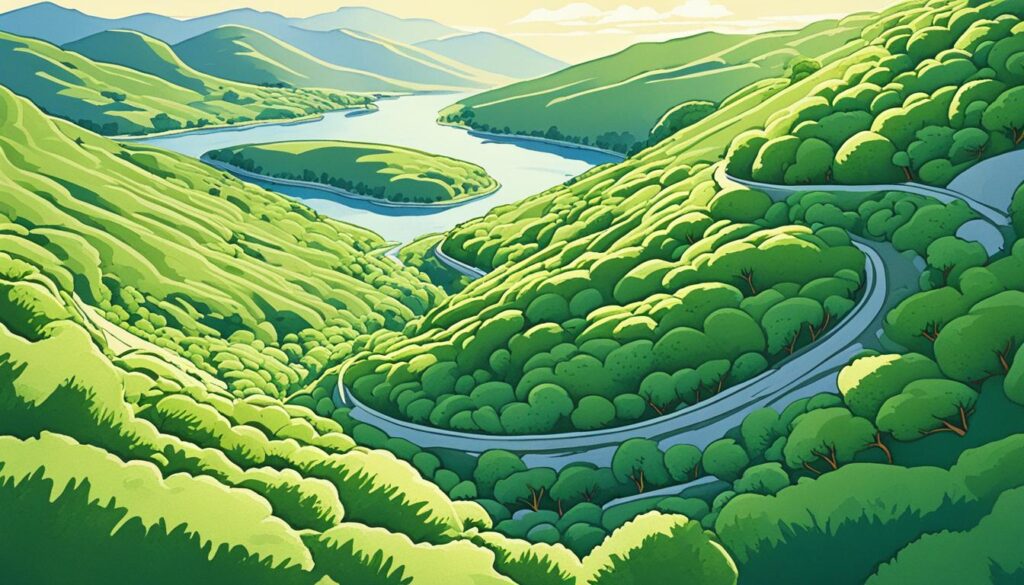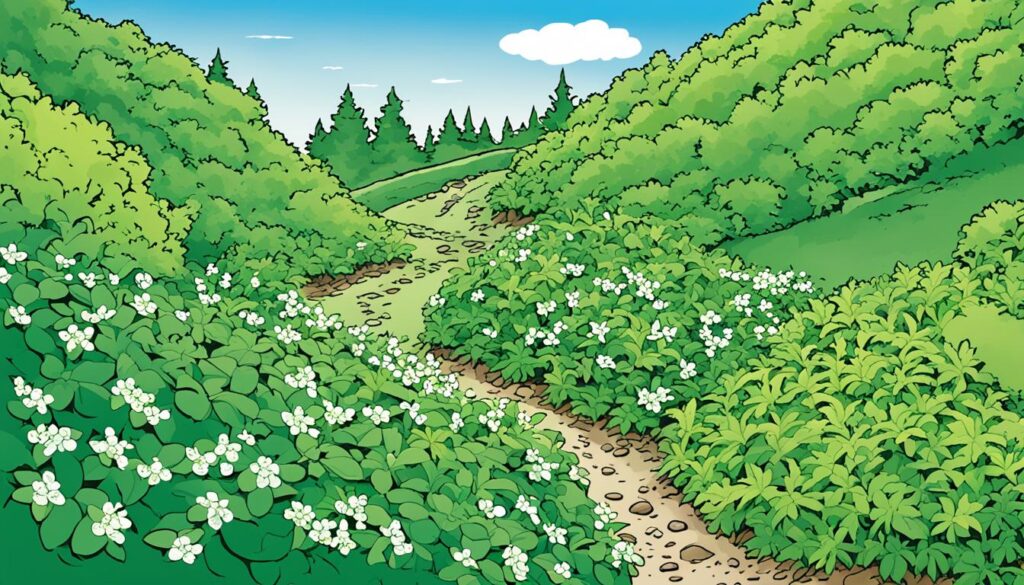Are you struggling with soil erosion in your yard? Do you find it challenging to maintain the integrity of your soil, especially on slopes? If so, you’re not alone. Soil erosion can wreak havoc on your landscaping efforts, causing damage to plants, compromising the stability of your yard, and even polluting waterways.
But fear not! There’s a solution to this problem – and it lies in the power of plants. Yes, you read that right. By strategically choosing the right plants, you can effectively control soil erosion and create a stable, thriving landscape.
In this article, we will delve into the world of soil erosion control and introduce you to the top 10 best plants that will anchor your soil and bring beauty to your yard. So, are you ready to discover these nature’s wonders? Let’s dive in!
Key Takeaways:
- Soil erosion can be a significant problem in yards, especially on slopes.
- Choosing the right plants is crucial for controlling erosion and stabilizing your soil.
- The top 10 best plants for soil erosion control will anchor your soil and bring beauty to your yard.
- Say goodbye to soil erosion woes as you discover the power of nature’s wonders.
- Get ready to transform your landscape into a stable and thriving haven with the help of these plants.
Big Blue Lilyturf (Liriope muscari)
When it comes to controlling erosion in your yard, the big blue lilyturf is a reliable and attractive option. This broadleaf, clump-forming evergreen plant is known for its ability to tackle erosion problems and keep your soil in place.
One of the standout features of the big blue lilyturf is its beautiful purple flowers that bloom in late summer, adding a splash of color to your landscape. Additionally, once established, this plant requires little supplemental irrigation, making it a low-maintenance choice for erosion control.
The big blue lilyturf is suitable for USDA Hardiness Zones 5-10, meaning it can thrive in a wide range of regions. It prefers full sun to partial shade, allowing you flexibility in choosing the best spot for it in your yard. This versatile plant also adapts well to different soil types, including clay, loam, and sandy soils.
Key Features of Big Blue Lilyturf:
- Broadleaf, clump-forming evergreen
- Purple flowers in late summer
- Requires little supplemental irrigation once established
- Suitable for USDA Hardiness Zones 5-10
- Thrives in full sun to partial shade
- Grows well in clay, loam, and sandy soils
Choose big blue lilyturf to not only control erosion but also enhance the aesthetic appeal of your yard. Its vibrant flowers and easy-care nature make it a top choice for homeowners looking to stabilize their soil and create a beautiful landscape.
Creeping Juniper (Juniperus horizontalis)
When it comes to protecting soil on rocky or sandy slopes, one of the best options is the creeping juniper. This low-growing shrub is a popular choice for erosion control due to its ability to form a dense mat of evergreen needles. Not only does it add visual appeal to your landscape, but it also stabilizes the soil, preventing erosion.
The creeping juniper is a resilient plant that can thrive in various conditions. It is drought tolerant once established, making it an excellent choice for areas where water may be scarce. This low-growing shrub is suitable for USDA Hardiness Zones 3-9 and prefers full sun. It can adapt well to rocky and sandy soils, making it an ideal option for slopes where erosion control is crucial.
If you’re looking for a low-maintenance plant that offers both beauty and functionality, the creeping juniper is an excellent choice. Its dense foliage and low-growing habit make it an effective ground cover, preventing soil erosion and providing protection to the underlying soil. Whether you have a rocky slope or a sandy embankment, this low-growing shrub can help anchor your soil and keep it in place.

| Plant Name | Creeping Juniper |
|---|---|
| Plant Type | Low-growing shrub |
| Hardiness Zone | 3-9 |
| Sunlight Requirement | Full sun |
| Soil Preference | Rocky and sandy soils |
Creeping Phlox (Phlox subulata)
Creeping phlox is the perfect solution for controlling erosion while adding a burst of vibrant colors to your landscape. This low-growing ground cover forms a lush carpet of pink, lavender, violet, and red flowers, creating a stunning visual display.
Known for its ability to creep and spread, creeping phlox effectively stabilizes the soil, preventing erosion in your yard. Its dense foliage acts as a protective cover, anchoring the soil and reducing the risk of runoff.
Creeping phlox thrives in dry soils and loves the full sun. Its adaptability allows it to grow well in various soil conditions, including well-drained, slightly alkaline, sandy, and rocky soils—making it suitable for a wide range of landscapes. It is classified as a flowering ground cover and is suitable for USDA Hardiness Zones 3-9.
| Plant | Creeping Phlox |
|---|---|
| Plant Type | Ground Cover |
| Flower Color | Pink, Lavender, Violet, Red |
| Sun Exposure | Full Sun |
| Soil Conditions | Dry, Well-drained, Slightly Alkaline, Sandy, Rocky |
| Hardiness Zones | 3-9 |
Plant creeping phlox in areas prone to erosion, such as slopes or bare patches. Its spreading nature allows it to quickly establish and cover the vulnerable soil, providing erosion control and a burst of colors.
With its beauty and functionality, creeping phlox is a top choice for achieving both an aesthetically pleasing landscape and effective erosion control.
Japanese Spurge (Pachysandra terminalis)
When it comes to effective erosion control, few plants can match the versatility and resilience of Japanese Spurge. This shrubby ground cover, scientifically known as Pachysandra terminalis, not only adds aesthetic appeal to your landscape but also works diligently to protect against soil erosion.

The beautiful Japanese Spurge features delicate, white flowers that bloom in spring, creating an enchanting sight in your garden. But its true power lies in its evergreen foliage, which forms a dense, carpeted mat that anchors the soil and safeguards it from erosion.
This resilient ground cover thrives in partially shaded to fully shaded areas, making it an excellent choice for various locations in your yard. Whether you have a dense canopy of trees or a shaded slope, Japanese Spurge can withstand less intense sunlight and still flourish. Additionally, its adaptability allows it to be grown in USDA Hardiness Zones 4-9.
Not only does Japanese Spurge serve as an efficient soil protector, but it is also highly resilient in terms of terrain and soil conditions. It thrives in slightly acidic soils and performs best in well-drained environments. So, whether you have clay-based or loamy soil, Japanese Spurge will find a comfortable home in your garden.
The Benefits of Japanese Spurge for Erosion Control:
- Forms a dense, carpeted mat that prevents soil erosion
- Thrives in partially shaded to fully shaded areas
- Delicate white flowers add a touch of elegance
- Adaptable to various soil types and drainage conditions
- Provides long-lasting coverage and stability to steep slopes
“Japanese Spurge is nature’s armor against erosion. Its steadfast growth and dense foliage create a protective shield for your soil, ensuring your landscape remains intact.”
By incorporating Japanese Spurge into your erosion control strategy, you can have peace of mind knowing that your soil is secure and your landscape is visually captivating. Whether you have a sloping yard, rocky terrain, or need to stabilize embankments, Japanese Spurge is a reliable and efficient solution that adds beauty and resilience to your outdoor space.
| Japanese Spurge (Pachysandra terminalis) | |
|---|---|
| Light Requirements | Part shade to full shade |
| USDA Hardiness Zones | 4-9 |
| Soil Conditions | Slightly acidic, well-drained soils |
Mondo Grass (Ophiopogon japonicus)
If you’re looking for a versatile and beautiful ground cover that can control erosion, look no further than mondo grass. With its grass-like appearance and salt-tolerant nature, mondo grass is an excellent choice for coastal areas.
Mondo grass features arching leaves that create an elegant, flowing effect in your landscape. But its beauty doesn’t stop there. In the summer, this enchanting plant blooms petite, bell-shaped flowers in shades ranging from white to lilac, adding a touch of charm to your garden.
Whether you have full sun or part shade, mondo grass can thrive in various light conditions. It’s suitable for USDA Hardiness Zones 7-10, making it a great option for different regions.
When it comes to soil, mondo grass is quite adaptable. It can grow well in clay, loam, and well-drained soils, providing erosion control in different types of terrain.
Planting mondo grass in your yard not only helps control erosion but also adds a graceful, grassy touch to your landscape. Its hardiness and low-maintenance requirements make it an ideal choice for both beginner and experienced gardeners alike.
Mondo Grass Care Tips:
- Plant mondo grass in well-drained soil to prevent waterlogged conditions.
- Water regularly during the first year of planting to help establish the roots.
- Apply a layer of mulch to retain moisture and suppress weed growth around the plants.
- Trim back any browning or damaged leaves in late winter or early spring to promote new growth.
- Divide the plants every few years to maintain their vigor and prevent overcrowding.
| Plant Name | Growth Habit | Flower Color | Sunlight Requirements | USDA Hardiness Zones | Soil Type |
|---|---|---|---|---|---|
| Mondo Grass | Grass-like ground cover | White to lilac | Full sun to part shade | 7-10 | Clay, loam, well-drained |
Conclusion
Soil erosion can have devastating effects on your yard and the environment as a whole. However, by making the right choices and selecting the appropriate erosion control plants, you can effectively combat this issue and stabilize your soil. The top 10 plants mentioned in this article offer not only the ability to control erosion but also the opportunity to enhance the beauty of your landscape.
When incorporating these plants into your yard, it is crucial to consider their specific requirements. Pay attention to factors such as sunlight, soil type, and water needs to ensure their successful growth and erosion control capabilities. By doing so, you can anchor your soil and create a stable, thriving environment.
Don’t let soil erosion be a problem any longer. Take action and implement these erosion control plants into your landscape. Not only will you be preserving your yard, but you will also be making a positive impact on the environment. Choose the right plants, stabilize your soil, and enjoy a beautiful and erosion-free yard for years to come.
FAQ
What is soil erosion?
Soil erosion is the process where soil is moved or displaced from its original location by wind, water, or other agents.
Why is soil erosion a problem?
Soil erosion can lead to loss of topsoil, which is essential for plant growth. It can also cause water pollution and damage to infrastructure.
How do plants help control soil erosion?
Plants with low-growing ground covers anchor the soil with their roots and cover it with dense foliage, helping to stabilize and protect against erosion.
What are some plants that can control soil erosion?
Some plants that are effective in controlling soil erosion include Big Blue Lilyturf, Creeping Juniper, Creeping Phlox, Japanese Spurge, and Mondo Grass.
What are the preferred growing conditions for soil erosion control plants?
Different plants have different preferences, but in general, they prefer full sun to partial shade, well-drained soils, and are suitable for specific USDA Hardiness Zones.
